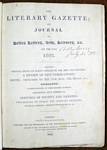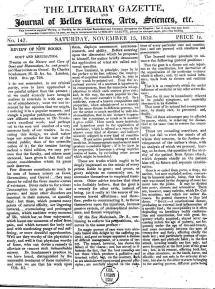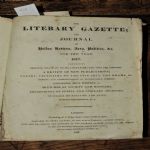Detailed Record
Literary Gazette, The;
vol 1 no 1?, 25 Jan 1817 - May 1860
then: Literary Gazette, The; a weekly journal etc. vol 1 no 2 [2s], Jul 1858 - vol 8 no 100 [2s], 26 Apr 1862
then: Parthenon, The. vol 1 no 1, 03 May 1862 - vol 2, 1863
then: Parthenon, The. vol 1 no 1, 03 May 1862 - vol 2, 1863
London,Middlesex (1858-1862)
J.M. Jephson (1856? - 1858)
William Jerdan (Jul 1817 - Dec 1850)
H.E. Lloyd
I.A. Reeve (1851 - 1856)
(Miss) Ross
William Jerdan (Jul 1817 - Dec 1850)
H.E. Lloyd
I.A. Reeve (1851 - 1856)
(Miss) Ross
Henry Colburn
William Jerdan (1841 - 1850)
William Jerdan (1841 - 1850)
John Bell
Henry Colburn
Literary Gazette Office (1819)
Lovell Reeve (1851)
Reeve and Co (1854)
W.A. Scripps (Literary Gazette Office 1825, 1846)
Henry Colburn
Literary Gazette Office (1819)
Lovell Reeve (1851)
Reeve and Co (1854)
W.A. Scripps (Literary Gazette Office 1825, 1846)
James Moyes (? - 1838)
Pinnock and Maunder
W. Pople (1819)
W. Scripps
J. Wheaton (1858-1862)
Whiting and Branston (1825)
Pinnock and Maunder
W. Pople (1819)
W. Scripps
J. Wheaton (1858-1862)
Whiting and Branston (1825)
J.B. Bell
William Blackwood
Karl Augustus Boettiger
William Lisle Bowles
Bowring (Dr.)
W.H. Brooke
Edward Bulwer-Lytton
Thomas Campbell
William Carey
Samuel Taylor Coleridge
Wilkie Collins
Eliza Cook
Barry Cornwall (1817)
George Crabbe (1817)
Croly (1817)
John Forster
G.L.H. Goulding
George Grote
Benjamin Haydon
(Mrs.) Hemans
James Hogg
Thomas Hood
Theodore Hook
John Camden Hotten (1862)
William Jerdan
John Keats
Charles Lamb
William Lamb
Laetitia E. Landon
J.G. Lockhart
William Maginn
Eliza Meteyard
Thomas Miller
Mary Russell Mitford (1817)
E. Moffat
T. Moore
J. Murray
(Mrs.) Norton
Francis Palgrave (Sir)
Thomas Peacock
Samuel Phillips
B.W. Proctor
Walter Scott
William Sotheby
Robert Southey
John Sutherland
Charles H. Swain
Isaac Taylor
Mackenzie Edward Charles Walcott (Rev.)
Alaric Alexander Watts
William Blackwood
Karl Augustus Boettiger
William Lisle Bowles
Bowring (Dr.)
W.H. Brooke
Edward Bulwer-Lytton
Thomas Campbell
William Carey
Samuel Taylor Coleridge
Wilkie Collins
Eliza Cook
Barry Cornwall (1817)
George Crabbe (1817)
Croly (1817)
John Forster
G.L.H. Goulding
George Grote
Benjamin Haydon
(Mrs.) Hemans
James Hogg
Thomas Hood
Theodore Hook
John Camden Hotten (1862)
William Jerdan
John Keats
Charles Lamb
William Lamb
Laetitia E. Landon
J.G. Lockhart
William Maginn
Eliza Meteyard
Thomas Miller
Mary Russell Mitford (1817)
E. Moffat
T. Moore
J. Murray
(Mrs.) Norton
Francis Palgrave (Sir)
Thomas Peacock
Samuel Phillips
B.W. Proctor
Walter Scott
William Sotheby
Robert Southey
John Sutherland
Charles H. Swain
Isaac Taylor
Mackenzie Edward Charles Walcott (Rev.)
Alaric Alexander Watts
Richard Oastler
Size:
25cm-28cm, 16pp (1817); 24pp (1846);
Price:
1s (1817); 1s8d (1826); 8d; 4d (1846); 5d (1846); 3d, 4d st (1851); 4d, 5d st (1856)
Circulation:
4,000/w, 16,000/m (1823); 2,000 (1855); 1,000 (1860); 499
Frequency:
weekly (1817, Sat 1846)
Illustration:
engravings
original correspondence, foreign and domestic, critical analysis of new publications English and foreign, varieties on all subjects connected with polite literature, discoveries and improvements, phenomena of nature and mind, philosophical researches, rural economy, scientific inventions, sketches of society, manner and morals, proceedings of universities, public societies &c., biographical memoirs of persons distinguished by their talents and public merits, original letters and anecdotes of remarkable personages, essays on the fine arts, review of British and foreign drama (including the Italian opera, with new music, etc), miscellaneous articles of literary intelligence, notices of works projected and in a state of forwardness, announcements of new publications and new editions, works of art; review of books, poetry, lectures, traits, stories, advertisements, encyclopaedia Britannica, college of physicians, horticultural society, politics, literary novelties, to correspondence
Orientation:
neutral; pro-Tory (1830); pro-authors' rights and international copyright law
Agassiz, Bibliographia Zoologiae; Cantor, Geoffrey and Jonathan R. Topham et al. Science in the Nineteenth-Century Periodical; reading the magazine of nature. Cambridge: Cambridge University Press, 2004.; Cooper, Dictionary of Contemporaries.; COPAC; DNB xi, p.433-438.; Faustus, Catalogue 59.; Fyfe, William Chambers and the Business of Publishing.; Jack, Scottish Newspaper Directory.; Leary, Manchester Periodicals ms p.356.; Mitchell's Newspaper Press Directory, 1846, 1847, 1851.; Mitchell.; Mitchell, Sally. The Fallen Angel: Chastity, Class and Women's Reading 1835-1880. Bowling Green, Ohio: Bowling Green University Popular Press, 1981.; Sper, Felix. Periodical Press of London, Theatrical & Literary. Boston: F.W. Faxon Co., 1937.; Sutherland Longman Companion to Victorian Fiction.; Uffelman, 1992.; White's The English Literary Journal To 1900; New Monthly Magazine 10 (Jan 1819): 538.; Ledbetter, Kathryn British Victorian Women's Periodicals: Beauty, Civilization, and Poetry. Palgrave Macmillan, 2009, p.1-207; Sumpter, Caroline. The Victorian Press and the Fairy Tale. Palgrave Macmillan, 2008, p.1-178; Peterson, Linda H. Becoming a Woman of Letters. Princeton: Princeton University Press, 2009, p.20,41.
Altick, Richard D. "Nineteenth-Century English Periodicals." The Newberry Library Bulletin 9 [2s] (May 1952): 255-73.; Bourne, H.R. Fox. English Newspapers. vol 1. New York: Russell & Russell, 1966.; Dudek, Literature and the Press.; Duncan, Robert W. "Byron and the London Literary Gazette." BUSE 2 (1956): 240-50.; Duncan, Robert W. "The London Literary Gazette and American Writers." PELL 1 (1965): 153-66.; Duncan, Robert W. "William Jerdan and the Literary Gazette." Ph.D. dissertation, University of Cincinatti, 1955.; Duncan, Robert in Sullivan, British Literary Magazines, vol 2, pp.242-246.; Elwin, Victorian Wallflowers.; Erickson, Economy of Literary Form.; Gates, Leigh Hunt.; Graham, British Literary Periodicals.; Grant, James. The Newspaper Press London: Tinsley Brothers, 1871.; Harris, Lee, Press in English Society.; Higgins, David. Romantic Genius and the Literary Magazine Biography, celebrity, politics. New York: Routledge, 2005.; Hunnisett, B. "Alaric Watts and the Literary Souvenir" ABMR 13 (1986): 132-5.; Latané, William Maginn and the British Press.; Lorraine De Montluzin, Emily. The Anti-Jacobins 1798-1800: the Early Contributors to the Anti-Jacobin Review. London: Macmillan Press, 1988.; Miller, Literary Radicalism and Late Victorian Print Culture.; Pyle, G.J., Jr. "The Literary Gazette under William Jerdan." PhD thesis, Duke, 1976. DAI 37 (1977): 7766-7A.; Roll-Hansen, Diderik. The Academy 1869-1879, Victorian Intellectuals in Revolt. Copenhagen: Rosenkilde and Bagger, 1957.; Shattock, Joanne and Michael Wolff, eds. The Victorian Periodical Press: Soundings and Samplings. Toronto: University of Toronto Press, 1982.; Schoch, Richard W. Shakespeare's Victorian Stage, Performing History in the Theatre of Charles Kean. Cambridge: Cambridge University Press, 1998.; Taylor, D.J. Thackeray. London: Random House, 1999.; Timperley, C.H. Encyclopaedia of Literary and Typographical Anecdote. New York: Garland Publishing Inc., 1977.; Thrall, Rebellious Fraser.; Trela, D.J. and Rodger L. Tarr. The Critical Response to Thomas Carlyle’s Major Works. Critical Responses in Art and Letters Series, Number 27. London: Greenwood Press, 1997.; Ward, J.T. The Factory Movement: 1830-1855. New York: MacMillan & Co Ltd, 1962.
The caption title sometimes reads London Literary Gazette. This was also the name of the unstamped version of the magazine, ca.1820.
Established January 1817.
"Eldest of the weekly journals, exclusively dedicated to literature, science, and the arts. It has long sustained its reputation, and is too well known to need much description: when it reigned without a rival, its decisions had almost as much of authority as official announcements in the Gazette. In process of time, however, there arose a competitor....But the old, original Gazette yet maintains 'high place' in literature; and, with the present year, a more popular character has been given to it by and increase in size" (Mitchell's, 1846).
Duncan writes that, between 3 July 1858 and 1863, the editors included a combination of Shirley Brooks, Henry Christman, W.R. Workman, Frederick Arnold, John Morley, C.W. Goodman (246)
It was one of several publications from this time that were designed to be "non-political weekly reviews featuring material extracted from a range of published books and other sources were placed before the public" (Cox & Mowatt 38).
"The reviews are characterised by a felicity of selection, which conveys a stronger impression of the works under examination than mere simple praise or censure can effect. Its pages combine the 'utile et dulce' of periodical criticism, and are often the first to promulgate the novelties of science and literature" (Mitchell's, 1847).
"The Contents...are arranged under the following heads: REVIEWS, SUMMARY, COMMUNICATIONS, and VARIETIES" (Advertisement in Mitchell's 1851).
"The value of the weekly for scholarship is vitiated by the lack of an office record. In Jerdan's...autobiography he names 200 contributors, with only a few of importance....[W]eaknesses in the magazine included Jerdan's reluctance to get innovative managerial assistance and the dearth of first-rate writers, especially after the decline in the early 1830s....Nevertheless...it was a greater literary authority than the respectable reviews for a large number of readers. A piece on a new novel insured a good sale if favourable, a poor one if condemnatory....The Gazette, never recovered from the blow of the Athenaeum's competition, and in circulation and authority it was relegated to a minor role until Jerdan's bankruptcy in 1850" (Duncan, Robert in Sullivan).
"Undertook to furnish...'a clear and instructive picture of the moral and literary improvement of the times and a complete and authentic chronological literary record for reference'" (Bourne, H.R. Fox, p.368).
"The Literary Gazette could be called the most notable successor to the Grub Street Journal to which Alexander Pope was an earlier contributor. The Gazette was established by Jerdan, who then occupied an important position within the English literary scene of the period. It placed greater emphasis on literature than did either the examiner or the champion....Special importance lay in its novel plan and experimental nature. Indeed, the literary gazette was astonishingly similar to the highly specialized weekly literary journals of the present time; each number containing on average two long reviews that included copious extracts from the works criticised. Two close imitations of The Literary Gazette followed in the next few years: The Literary Chronicle and The Literary Register. According to Graham: 'in its pages, the student may find a cross-section of the literary activity of three decades the 'annals of the Republic' of letters' " (Faustus, Catalogue 59).
All or part of their impression was printed on unstamped paper.
The New Monthly Magazine records that an annual version of this was also issued in the year 1818 (New Monthly Magazine p. 538).
"[I]n January 1818...the Literary Gazette claimed to be the first weekly paper to be printed by steam" (Topham, p.41).
Graham: "The greater importance of the Literary Gazette, however, lay in its 'novel' plan and 'experimental' nature. At the end of the second of unqualified success, the Gazette contained a self-congratulatory article...in which it was declared that over four hundred new works had been reviewed, 'with extracts'; that some fifty biographical memoirs had been published; and that the Gazette had omitted 'no notice of consequence to the fine arts or science'" (315).
Laetitia E. Landon, one of England's most popular poetesses, became the chief reviewer for the Literary Gazette (Thrall 193). Thrall also explains that "no woman could at that time have held her position on the Gazette without becoming the center of scandal" but also mentions that literary attacks were sometimes considered an honour (194).
Its main rival was Thackeray's National Standard (Taylor, p.222).
Established January 1817.
"Eldest of the weekly journals, exclusively dedicated to literature, science, and the arts. It has long sustained its reputation, and is too well known to need much description: when it reigned without a rival, its decisions had almost as much of authority as official announcements in the Gazette. In process of time, however, there arose a competitor....But the old, original Gazette yet maintains 'high place' in literature; and, with the present year, a more popular character has been given to it by and increase in size" (Mitchell's, 1846).
Duncan writes that, between 3 July 1858 and 1863, the editors included a combination of Shirley Brooks, Henry Christman, W.R. Workman, Frederick Arnold, John Morley, C.W. Goodman (246)
It was one of several publications from this time that were designed to be "non-political weekly reviews featuring material extracted from a range of published books and other sources were placed before the public" (Cox & Mowatt 38).
"The reviews are characterised by a felicity of selection, which conveys a stronger impression of the works under examination than mere simple praise or censure can effect. Its pages combine the 'utile et dulce' of periodical criticism, and are often the first to promulgate the novelties of science and literature" (Mitchell's, 1847).
"The Contents...are arranged under the following heads: REVIEWS, SUMMARY, COMMUNICATIONS, and VARIETIES" (Advertisement in Mitchell's 1851).
"The value of the weekly for scholarship is vitiated by the lack of an office record. In Jerdan's...autobiography he names 200 contributors, with only a few of importance....[W]eaknesses in the magazine included Jerdan's reluctance to get innovative managerial assistance and the dearth of first-rate writers, especially after the decline in the early 1830s....Nevertheless...it was a greater literary authority than the respectable reviews for a large number of readers. A piece on a new novel insured a good sale if favourable, a poor one if condemnatory....The Gazette, never recovered from the blow of the Athenaeum's competition, and in circulation and authority it was relegated to a minor role until Jerdan's bankruptcy in 1850" (Duncan, Robert in Sullivan).
"Undertook to furnish...'a clear and instructive picture of the moral and literary improvement of the times and a complete and authentic chronological literary record for reference'" (Bourne, H.R. Fox, p.368).
"The Literary Gazette could be called the most notable successor to the Grub Street Journal to which Alexander Pope was an earlier contributor. The Gazette was established by Jerdan, who then occupied an important position within the English literary scene of the period. It placed greater emphasis on literature than did either the examiner or the champion....Special importance lay in its novel plan and experimental nature. Indeed, the literary gazette was astonishingly similar to the highly specialized weekly literary journals of the present time; each number containing on average two long reviews that included copious extracts from the works criticised. Two close imitations of The Literary Gazette followed in the next few years: The Literary Chronicle and The Literary Register. According to Graham: 'in its pages, the student may find a cross-section of the literary activity of three decades the 'annals of the Republic' of letters' " (Faustus, Catalogue 59).
All or part of their impression was printed on unstamped paper.
The New Monthly Magazine records that an annual version of this was also issued in the year 1818 (New Monthly Magazine p. 538).
"[I]n January 1818...the Literary Gazette claimed to be the first weekly paper to be printed by steam" (Topham, p.41).
Graham: "The greater importance of the Literary Gazette, however, lay in its 'novel' plan and 'experimental' nature. At the end of the second of unqualified success, the Gazette contained a self-congratulatory article...in which it was declared that over four hundred new works had been reviewed, 'with extracts'; that some fifty biographical memoirs had been published; and that the Gazette had omitted 'no notice of consequence to the fine arts or science'" (315).
Laetitia E. Landon, one of England's most popular poetesses, became the chief reviewer for the Literary Gazette (Thrall 193). Thrall also explains that "no woman could at that time have held her position on the Gazette without becoming the center of scandal" but also mentions that literary attacks were sometimes considered an honour (194).
Its main rival was Thackeray's National Standard (Taylor, p.222).
Location:
complete runs: MA/S-2, BH/P-1 G, LO/N-1 A, LD/U-1, LO/S-7, MA/S-2 H, Sutherland Public Library; partial runs: QZ/P-1 G (1849-1862), LO/U-1 G 3:147-no 467 (13 Nov 1819-31 Dec 1825), CA/U-1 A 690 (10 Apr 1830), XY/N-1 A; OX/U-1 A no 1 (1817, 1833); ED/N-1 A (1817 Prospectus); REPRINT EDITIONS: microform: English Literary Periodicals (UMI), reels 907-920; N.America: ICN (see Altick), Kraus Microform, Millwood, N.Y., New York Public Library, NjP, Three M-IM Press, Washington, D.C.; see Fulton, ULS 2&3, and Sullivan. The full text is available at ProQuest and in Hathitrust.org (1817-1840)




